Course
Description
This course guides students through
the principles of American government and the responsibilities of citizenship
on federal, state and local levels. The
United States Constitution provides the structure for much of the course, along
with several other significant documents including the Ohio State Constitution
of 1851. Students are encouraged to
address current issues and policies through public processes. Government’s role in the economic realm will
also be discussed.
GOVERNMENT OVERVIEW
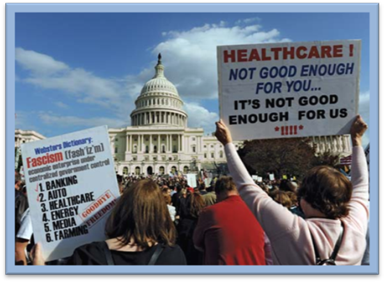
Protest March:
Washington D.C.
Unit Overview
Welcome to American Government! In this unit, you will review some of the
various types of government and consider several basic principles that shape
the rule of law in the United States.
Significant documents such as the Mayflower Compact and the Articles of
Confederation will also be discussed.
Forms
of Government
Government
can be defined as the institutions and people that have the power to establish
and to enforce public policies.
Countries rely on it to keep order, to provide public services and to
maintain national defense. Almost
everyone is critical of their nation’s authority from time to time, but anarchy or the absence of government
creates greed, chaos and confusion. Most
forms of government fall into three broad categories: monarchy,
dictatorship and democracy.
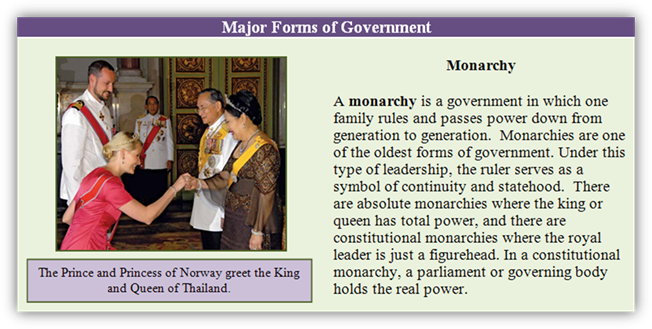
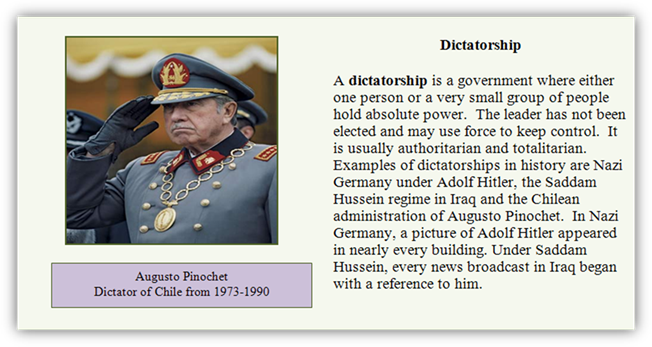
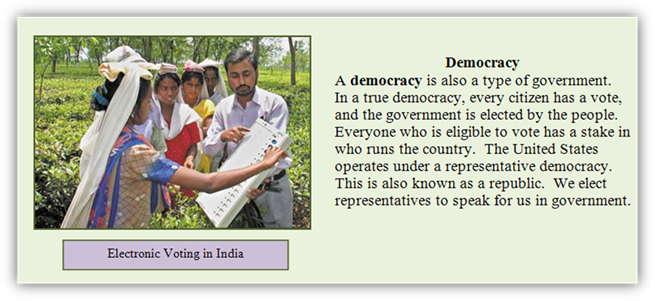
For more information about specific
forms of government click on the PDF File.
![]() Go to Questions
1-3.
Go to Questions
1-3.
Basic Principles of American Government
The United States fits in the broad
category of democracy, but it has been shaped and molded by several basic
principles. These terms have been
analyzed, redefined and broadened by every generation of Americans since
colonial times.
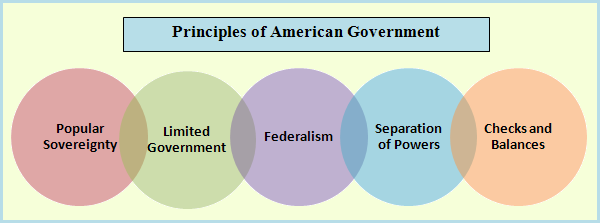
§
Popular Sovereignty
Popular
sovereignty is the idea that a government’s power comes from the people that
are being governed. It is based on the
concept of a social contract between the leaders and the citizens. For Americans, it means that the political
leadership is controlled by the people through their votes. This principle was established with a
democratic document known as the Mayflower Compact. To read this document, click on the PDF file
below.
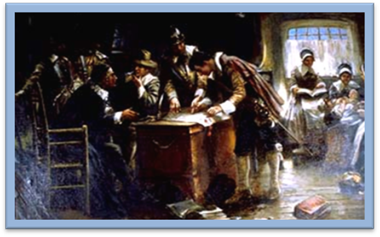
Signing of the Mayflower Compact (U.S. Public Domain)
In 1620, the
Pilgrims reached what they thought was northern Virginia. The Compact is often described as America's
first constitution, but it is not a constitution in the sense of being a
fundamental framework of government. Its importance lies in the belief that
government is a form of covenant or contract; for an authority to be
legitimate, it must originate from the consent of the governed. Popular sovereignty was often cited before
the Civil War as a reason why individuals in newly organized territories had
the right to decide the slavery question.
§
Limited Government
When the United
States developed its plan for government, the organizers wanted to avoid the
massive size and power held by European leaders in the eighteenth century. With this in mind, they designed a central
authority based on the principle of limited government. This means that the people are the only real
source of the government’s power. They
state how much control they want the government to have through free elections
and laws. This assures that leaders do
not misuse their authority and that they respect the rights of individuals.
The principle of
limited government is continuously being redefined on local, state and federal
levels. Government regulations have
increased over the past two hundred years as the United States has changed from
a farming nation to a complex, technological society. This has also fueled concerns about the
government’s right to interfere in certain situations. Every political issue, from healthcare to
international trade, questions how far the government’s power should extend.
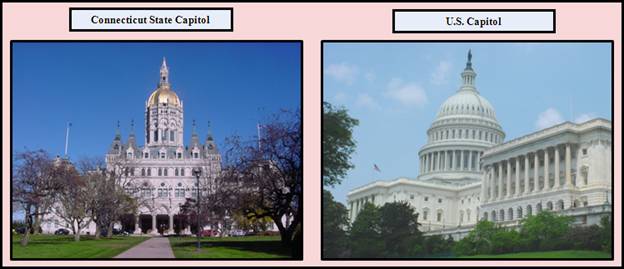
§
Federalism
The division of
power between a central authority and a regional authority, such as a state, is
known as federalism. This system was
designed to solve the problem of the relationship between the national and
states governments. Although a strong
case was made for a very powerful, national government, states did not want to
surrender control over their internal affairs to a centralized authority. As a result, some powers were given to the
national government, and some powers were kept by the states.
Federalism
permits states to have their own constitutions, laws, courts and
officials. The protection of the country
as a whole and the settlement of disputes between states are left to the
federal government. In The Federalist
(Number 46), James Madison described it this way: “The federal and state governments are in
fact but different agents and trustees of the people, instituted with different
powers, and designated for different purposes.”
There are times, however, when national, state and local policies
conflict. In these circumstances, state
and local governments cannot challenge or contradict the constitutional
authority of the national government.
Separation
of Powers
The framers of American government
recognized the need for a strong, central government. At the same time, they were concerned that
certain groups or individuals might acquire too much authority or remain in
office too long. As a result, a
separation of powers became the basis for American government. This concept, adopted from the writings of a
French political philosopher named Baron de Montesquieu, divided control among
three branches: legislative, executive
and judicial. Each branch has specific
responsibilities, powers and restrictions.
The legislative branch has the authority to enact laws and to establish
policies for the national government.
The role of the executive branch is to carry out, administer and enforce
federal policies. The interpretation of
the law is the domain of the Supreme Court.
Checks
and Balances
American government relies on
checks and balances to make sure that no single branch of government operates
without restraint. Each branch of
government exercises some control over the other two. This prevents the accumulation of too much
power in the hands of a few people. For
example, the President can veto a law passed by Congress, but Congress can
override that veto with a 2/3 vote. The
Supreme Court can also check the power of the President by declaring the law
unconstitutional. To keep the Supreme
Court in check, the Justices are appointed by the President and approved by
Congress.
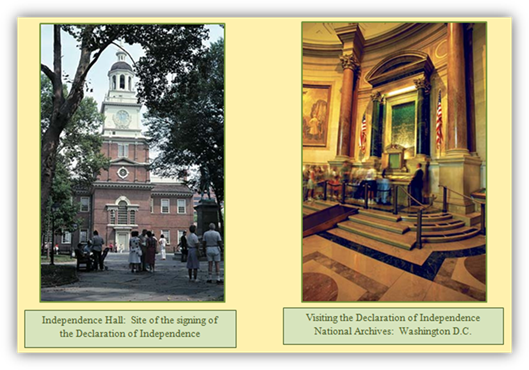
![]() Go the Questions 4-11.
Go the Questions 4-11.
The
Establishment of an Independent Nation
When the
French and Indian War ended in 1763, Britain took complete control of the
American colonies. France had conceded
land that it had formerly held in the Ohio Valley and east of the Mississippi
River. Britain was a monarchy ruled by
King George III and a Parliament with a Prime Minister. Because the colonies
were so far away from Britain and the Parliament, each colonial government did
pretty much as it pleased.
As with
all wars, the French and Indian War was a costly one in both men and
money. To help pay for war debts and for
the protection of the colonials from Indian attacks, the British Parliament
levied several taxes against the colonies.
These taxes upset the British citizens in America because they felt that
they had no representation in Parliament.
Cries of “taxation without representation” became a rallying point for
the colonies to break away from Britain and to become independent from the
mother country.
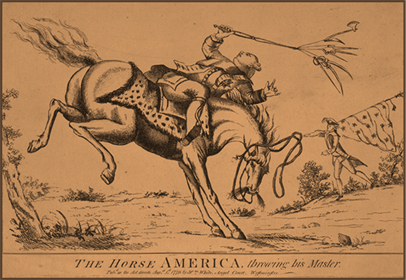
The
document that the colonists wrote to explain their reasons for breaking away
from England was the Declaration of Independence. The Declaration is an indictment of George
III for willfully infringing upon the colonials' rights in order to establish
an “absolute Tyranny” over the colonies.
In this document, Thomas Jefferson, the primary writer, listed
grievances that the colonies had with the government of King George III and
that colonial patience had achieved nothing.
He also added a remedy for that problem, independence from the mother
country. Although a radical step, it
was one that some of the Founding Fathers felt it was necessary. Who were the men that were brave enough to
put their names on this document? Click
on the link below to learn more about their life stories.
A
complete list of the signers of the Declaration of Independence can be viewed
in the Declaration of Independence Signers.PDF.
![]() Go to Questions 12-14
Go to Questions 12-14
The First
National Constitution
While
Thomas Jefferson was writing the Declaration of Independence, another committee
began working on a plan to form a confederation composed of the former British
colonies. The result of their work was a
document called the Articles of
Confederation. Since Americans did
not want to open the country up to the possibility of another monarchy, they
created a three-man committee instead of a chief executive or President. Very limited powers were given to a Congress,
which was the central authority in the new government. States appointed between two and seven
representatives to this legislature, but each state only had one vote, even if
its population was very large. After
months of debate, the Articles went into effect in March of 1781, but it soon
became apparent that there were flaws in this plan.
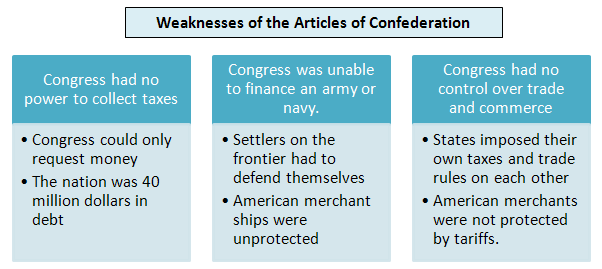
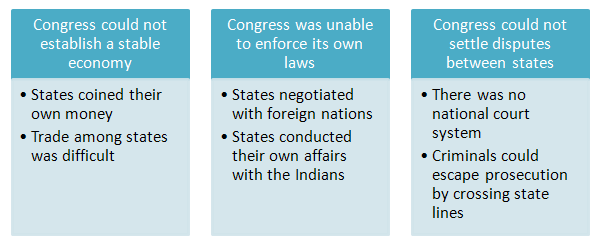
Successes
under the Articles of Confederation
In spite
of serious weaknesses, the Articles of Confederation did achieve some
success. Under the guidance of this
document, the United States managed to win the Revolutionary War and to
negotiate a treaty with Great Britain.
The new government also established committees to handle financial,
military and foreign affairs. This set
the precedent for the Departments of the Treasury, Defense and State.
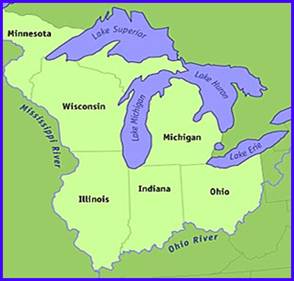
States from the Northwest
Territory www.dipity.com
One of
the most impressive accomplishments of the Confederation was the passage of the
Northwest Ordinance. This act provided the political structure for
the land north of the Ohio River and west to the Mississippi River. The Ordinance established the process by
which three to five new states would be formed from these lands. According to the Northwest Ordinance, the new
states would enter the union on equal terms with the existing states. The settlers in the territories were
guaranteed religious freedom, and slavery was outlawed. The Ordinance became the model for all
territories that desired statehood.
![]() Go to Questions 15-16.
Go to Questions 15-16.
What’s Next?
Although
government under the Articles of Confederation did achieve some success, many
people soon realized that a stronger government was necessary. The new country’s economic problems were
rapidly becoming more serious. States
issued their own money, but inflation soon made these currencies
worthless. This hurt small businesses
and lowered prices farmers received for their produce. Frustration put people in many states on the
verge of rebellion.
In
Massachusetts, for example, hundreds of angry farmers and workers, led by Revolutionary
War veteran Daniel Shays, came together and marched on a number of county
courthouses. The chaos made leaders in
every state realize that changes needed to be made if the young nation was
going to survive. Five states sent
representatives to a meeting in Annapolis, Maryland in 1786. After much discussion, the delegates strongly
recommended that all states send representatives to Philadelphia, Pennsylvania
in May of 1787 for the purpose of revising the Articles of Confederation. Could the Articles be revised? Would the states overcome their fear of a
strong, central government and agree to change?
Continue your study of American Government to find the answers to these
and other questions.
![]() Go the Questions 17-24.
Go the Questions 17-24.

Below are additional educational resources and activities for this unit.